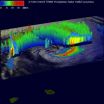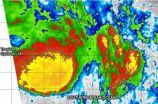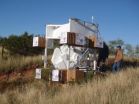(Press-News.org) The first clinical trial of a drug intended to delay the onset of symptoms of Huntington disease (HD) reveals that high-dose treatment with the nutritional supplement creatine was safe and well tolerated by most study participants. In addition, neuroimaging showed a treatment-associated slowing of regional brain atrophy, evidence that creatine might slow the progression of presymptomatic HD. The Massachusetts General Hospital (MGH) study also utilized a novel design that allowed participants – all of whom were at genetic risk for the neurodegenerative disorder – to enroll without having to learn whether or not they carried the mutation that causes HD.
"More than 90 percent of those in the United States who know they are at risk for HD because of their family history have abstained from genetic testing, often because they fear discrimination or don't want to face the stress and anxiety of knowing they are destined to develop such a devastating disease," says H. Diana Rosas, MD, of the MassGeneral Institute for Neurodegenerative Disease (MGH-MIND), lead and corresponding author of the paper that will appear in the March 11 issue of Neurology and has been released online. "Many of these individuals would still like to help find treatments, and this trial design allows them to participate while respecting their autonomy, their right not to know their personal genetic information."
Among the ways that the mutated form of the huntingtin protein damages brain cells is by interfering with cellular energy production, leading to a depletion of ATP, the molecule that powers most biological processes. Known to help restore ATP and maintain cellular energy, creatine is being investigated to treat a number of neurological conditions – including Parkinson disease, amyotrophic lateral sclerosis and spinal cord injury. Studies in mouse models of HD showed that creatine raises brain ATP levels and protects against neurodegeneration. Previous clinical trials of creatine in symptomatic HD patients have been limited in scale, involved daily doses of 10 grams or less, and did not provide evidence of potential efficacy. Based on the results of a pilot study at MGH that evaluated doses as high as 40 grams, participants in the current study received doses of up to 30 grams daily.
The phase II PRECREST trial enrolled 64 adult participants - 19 who knew they carried the mutated form of the HD gene and 45 with a 50 percent risk of having inherited the HD mutation. Genetic testing, results of which were made available only to the study statistician and not to study staff or participants, confirmed the genetic status of those who had previously been tested and revealed an additional 26 presymptomatic carriers of the mutated gene, for a total of 47 participants with presymptomatic HD and 17 controls.
For the first 6 months of the trial, participants were randomized into two groups, regardless of gene status. One group received twice-daily oral doses of creatine, up to a maximum of 30 grams per day, the other received placebo. After that first phase, all participants received creatine for an additional 12 months. Participants were assessed at regular study visits for adverse effects, and dosage levels were adjusted, if necessary, to reduce unpleasant side effects. Additional tests – cognitive assessments, measurement of blood markers and MRI brain scans – were conducted at the trial's outset, at 6 months and at the end of the study period.
During the first phase of the trial more than three-quarters of those randomized to creatine tolerated a daily dose of 15 grams or more, and more than two -thirds tolerated the full 30-gram dose. Throughout the entire trial, a total of 15 participants – including several who knew they carried the HD mutation – discontinued taking creatine because of gastrointestinal discomfort, the taste of the drug, inconvenience, or the stress of being constantly reminded of their HD risk. Other than occasional diarrhea and nausea, few adverse events were associated with creatine.
In participants who carried the HD mutation, the MRI scans taken at the outset of the trial had revealed significant atrophy in regions of the cerebral cortex and basal ganglia known to be affected by the disease. Followup MRI scans at six months showed a slower rate of atrophy in participants taking creatine compared to those on placebo. At the end of the second phase, the rate of brain atrophy had also slowed in presymptomatic participants that started taking creatine after 6 months on placebo.
In addition to suggesting that creatine could slow the progression of HD, these results also imply that neuroimaging may provide a useful biomarker of disease modification in studies of other potential treatments. While participants with the mutation had performed less well than controls on the cognitive tests at the study outset, creatine treatment had no significant effect on those measures, possibly because the tests were not sensitive enough to detect subtle changes that might occur during such a brief time period, the authors note.
"The results of this trial suggest that the prevention or delay of HD symptoms is feasible, that at-risk individuals can participate in clinical trials – even if they do not want to learn their genetic status – and that useful biomarkers can be developed to help assess therapeutic benefits," says senior author Steven Hersch, MD, PhD, of MGH-MIND. "In addition, we believe our study design sets an important precedent for other genetic diseases and will help inform discussions of how clinical research can coexist with deep concerns about genetic privacy and patient autonomy."
INFORMATION:
Hersch, a professor of Neurology at Harvard Medical School, and Rosas, an associate professor, are currently leading a world-wide Phase III trial (CREST-E) of high-dose creatine in individuals with early symptomatic HD. Conducted in collaboration with Giovanni Schifitto, MD, MS, of the University of Rochester, the trial is sponsored by the National Center for Complementary and Alternative Medicine. Additional information on this trial, which is still open for enrollment, is available at http://bit.ly/1gMzLIs.
Additional co-authors of the Neurology report are Sona Gevorkian MSc, Keith Malarick, Martin Reuter, PhD, Jean-Philippe Coutu, Tyler Triggs, and Paul Wilkens, MGH Neurology; David Salat PhD, Martinos Center for Biomedical Imaging, MGH; Gheorghe Doros, PhD, Boston University School of Public Health; and Wayne Matson, PhD, New England Veterans Administration. The study was supported by National Institutes of Health grants P01NS058793, NS042861, NS058793, AT000613, FD003359 and NS058793.
Massachusetts General Hospital, founded in 1811, is the original and largest teaching hospital of Harvard Medical School. The MGH conducts the largest hospital-based research program in the United States, with an annual research budget of more than $775 million and major research centers in AIDS, cardiovascular research, cancer, computational and integrative biology, cutaneous biology, human genetics, medical imaging, neurodegenerative disorders, regenerative medicine, reproductive biology, systems biology, transplantation biology and photomedicine.
Huntington disease prevention trial shows creatine safe, suggests slowing of progression
Novel study design allows participation of at-risk individuals who do not want to know their genetic status
2014-02-08
ELSE PRESS RELEASES FROM THIS DATE:
Stroke trigger more deadly for African-Americans
2014-02-08
ANN ARBOR, Mich. — Infection is a stronger trigger of stroke death in African- Americans than in whites, a University of Michigan study shows.
African-Americans were 39 times more likely to die of a stroke if they were exposed to an infection in the previous month when compared to other time periods while whites were four times more likely and Hispanics were five times more likely to die of stroke after an infection, according to the findings that appear online Feb. 7 in Neurology.
The most frequent infections were urinary, skin, and respiratory tract infections ...
Women fare worse than men following stroke
2014-02-08
WINSTON-SALEM, N.C. – Feb. 7, 2014 – The good news: More people survive stroke now than 10 years ago due to improved treatment and prevention.
The bad news: Women who survive stroke have a worse quality of life than men, according to a study published in the Feb. 7 online issue of the journal Neurology.
Researchers at Wake Forest Baptist Medical Center compared the quality of life in men and women who had a stroke or transient ischemic attack (TIA). A total of 1,370 patients ages 56 to 77 from the AVAIL registry – a national, multicenter, longitudinal registry of ischemic ...
New application of physics tools used in biology
2014-02-08
A Lawrence Livermore National Laboratory physicist and his colleagues have found a new application for the tools and mathematics typically used in physics to help solve problems in biology.
Specifically, the team used statistical mechanics and mathematical modeling to shed light on something known as epigenetic memory -- how an organism can create a biological memory of some variable condition, such as quality of nutrition or temperature.
"The work highlights the interdisciplinary nature of modern molecular biology, in particular, how the tools and models from mathematics ...
Social or stinky? New study reveals how animal defenses evolve
2014-02-08
When people see a skunk, the reaction usually is "Eww," but when they see a group of meerkats peering around, they often think "Aww."
Why some animals use noxious scents while others live in social groups to defend themselves against predators is the question that biologists Tim Caro of the University of California, Davis and Theodore Stankowich of California State University, Long Beach and sought to answer through a comprehensive analysis of predator-prey interactions among carnivorous mammals and birds of prey.
Their findings appear in the online edition of the ...
Endocrine Society calls for large-scale studies to evaluate testosterone therapy risks
2014-02-08
Chevy Chase, MD—According to a statement issued today by the Endocrine Society, the risks and benefits of testosterone therapy for older men with declining levels of the hormone need to be fully evaluated.
The statement comes in response to recent studies that have raised concerns about the safety of testosterone therapy in older men with a history of heart disease. Two retrospective analyses and one randomized trial supported by the Veterans Health Care System, and the National Institutes of Health found a higher rate of cardiovascular events in men who received testosterone ...
NASA spots very heavy rainfall rates in Tropical Cyclone Edilson
2014-02-08
Imagine receiving as much as 7 inches of rain in one hour. That's about what NASA's TRMM satellite spotted falling in one area within Tropical Cyclone Edilson as it moved over the Southern Indian Ocean.
The Tropical Rainfall Measuring Mission or TRMM satellite is managed by both NASA and the Japan Aerospace Exploration Agency called JAXA. TRMM can read the rate in which rain is falling on Earth while in its orbit high above.
The TRMM satellite had an excellent early morning look at Edilson on February 7, 2014 at 0237 UTC/06:28 local time when it passed directly above ...
Diaphragm pacing in spinal cord injury successful in weaning patients from ventilators
2014-02-08
CLEVELAND – A new study published in the Journal of Trauma and Acute Care Surgery finds that diaphragm pacing (DP) stimulation in spinal cord-injured patients is successful not only in weaning patients from mechanical ventilators but also in bridging patients to independent respiration, where they could breathe on their own without the aid of a ventilator or stimulation.
The stimulation is provided by the Diaphragm Pacing System (DPS), a technology providing electrical stimulation to nerves running through the diaphragm, the major muscle involved in breathing. When stimulated, ...
NASA spots fourteenth tropical cyclone of Southern Indian Ocean season
2014-02-08
The fourteenth tropical cyclone of the Southern Indian Ocean season was born as NASA's Terra satellite passed overhead.
On February 7 at 0900 UTC/4 a.m. EST, Tropical Cyclone 14S had maximum sustained winds near 35 knots/40 mph/62 kph. It was located about 814 nautical miles/936.7 miles/1,508 km east-northeast of Port Louis, Mauritius near 14.8 south and 70.4 east. At that time, 14S was moving to the south near 8 knots/9.2 mph/14.8 kph.
The Joint Typhoon Warning Center noted that multispectral satellite imagery showed that the low-level center is exposed to outside ...
Thinking skills take biggest hit from anxiety in midlife women with HIV
2014-02-08
CLEVELAND, Ohio (Friday, February 7, 2014)—Hot flashes, depression, and most of all, anxiety, affect the thinking skills of midlife women with HIV, so screening for and treating their anxiety may be especially important in helping them function, according to a study just published online in Menopause, the journal of The North American Menopause Society (NAMS). The reproductive stage, whether it was premenopause, perimenopause or postmenopause, did not seem to be related to these women's thinking skills.
The conclusions come from a new analysis of data on 708 HIV-infected ...
WASP gives NASA's planetary scientists new observation platform
2014-02-08
Scientists who study Earth, the sun and stars have long used high-altitude scientific balloons to carry their telescopes far into the stratosphere for a better view of their targets. Not so much for planetary scientists. That's because they needed a highly stable, off-the-shelf-type system that could accurately point their instruments and then track planetary targets as they moved in the solar system.
That device now exists.
NASA's Wallops Flight Facility in Wallops Island, Va., has designed a new pointing system — the Wallops Arc Second Pointer (WASP) — that can point ...
LAST 30 PRESS RELEASES:
Oldest modern shark mega-predator swam off Australia during the age of dinosaurs
Scientists unveil mechanism behind greener ammonia production
Sharper, straighter, stiffer, stronger: Male green hermit hummingbirds have bills evolved for fighting
Nationwide awards honor local students and school leaders championing heart, brain health
Epigenetic changes regulate gene expression, but what regulates epigenetics?
Nasal drops fight brain tumors noninvasively
Okayama University of Science Ranked in the “THE World University Rankings 2026” for the Second Consecutive Year
New study looks at (rainforest) tea leaves to predict fate of tropical forests
When trade routes shift, so do clouds: Florida State University researchers uncover ripple effects of new global shipping regulations
Kennesaw State assistant professor receives grant to improve shelf life of peptide- and protein-based drugs
Current heart attack screening tools are not optimal and fail to identify half the people who are at risk
LJI scientists discover how T cells transform to defend our organs
Brain circuit controlling compulsive behavior mapped
Atoms passing through walls: Quantum tunneling of hydrogen within palladium crystal
Observing quantum footballs blown up by laser kicks
Immune cells ‘caught in the act’ could spur earlier detection and prevention of Type 1 Diabetes
New membrane sets record for separating hydrogen from CO2
Recharging the powerhouse of the cell
University of Minnesota research finds reducing inflammation may protect against early AMD-like vision loss
A mulching film that protects plants without pesticides or plastics
New study highlights key findings on lung cancer surveillance rates
Uniform reference system for lightweight construction methods
Improve diet and increase physical activity at the same time to limit weight gain, study suggests
A surprising insight may put a charge into faster muscle injury repair
Scientists uncover how COVID-19 variants outsmart the immune system
Some children’s tantrums can be seen in the brain, new study finds
Development of 1-Wh-class stacked lithium-air cells
UVA, military researchers seek better ways to identify, treat blast-related brain injuries
AMS Science Preview: Railways and cyclones; pinned clouds; weather warnings in wartime
Scientists identify a molecular switch to a painful side effect of chemotherapy
[Press-News.org] Huntington disease prevention trial shows creatine safe, suggests slowing of progressionNovel study design allows participation of at-risk individuals who do not want to know their genetic status




